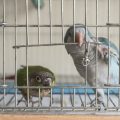The Monk Parakeet (also known as the Quaker Parrot) is a unique and fascinating species of parakeet that has been captivating bird lovers for centuries. Native to South America, the Monk Parakeet is renowned for its intelligence, playful personality, and ability to build large, complex nests.
Despite its exotic origins, the Monk Parakeet is now an established species in many parts of the world due to its popularity as a pet and its hardy nature. In recent years, the Monk Parakeet has become an increasingly common sight in many parts of the United States, particularly in urban areas.
The Monk Parakeet is a large bird with bright green feathers and blue-tipped wing feathers. It has a long tail and an overall length of 12-14 inches. Its wingspan can reach up to 20 inches and it weighs between 4-7 ounces. These birds are highly social and tend to live in small flocks that build massive communal nests called “condos” that can be quite large (up to 3 feet wide).
These birds have also earned a reputation for their vocal abilities—they can mimic human speech! This makes them popular pets for those looking for an interesting talking companion.
In addition to their popularity as pets, Monk Parakeets have become notorious pests in some areas due to their tendency to build large nests on electric utility poles and other infrastructure. These nests can cause power outages or fires if they come into contact with electrical wires. As such, these birds have become somewhat of a nuisance in certin areas where their populations have grown unchecked.
Fortunately, there are ways to manage these populations without resorting to lethal control methods such as trapping or euthanasia. Nonlethal methods such as using barriers or repellents around nesting sites can be effective at discouraging nesting activities without having any negative impact on these beautiful birds or their habitats.
Ultimately, the Monk Parakeet is an interesting species with plenty of potential both as a pet and as part of our natural ecosystem—as long as we take steps to ensure that their populations are managed responsibly!
The Problem of Monk Parakeets
Monk parakeets are a problem because their nest-building behavior can cause a range of issues for electric utility facilities. The nests they build can interfere with the operation of power lines, leading to power outages and other equipment damage. In addition, the bird’s droppings can accumulate on electrical equipment and corrode or damage insulation, resulting in potential arcing or fire hazards. Furthermore, the nests thmselves have been known to heat up due to the close proximity of energized wires, creating additional fire risks. Finally, the birds may also present a threat to aircraft as they fly around power lines and transmission towers.

Source: en.wikipedia.org
Is a Monk Parakeet a Good Pet?
Monk parakeets, also kown as Quaker parrots, can make very good pets for people who are willing to devote the time and energy to providing them with an enriching environment. They are intelligent and playful birds who thrive when they receive plenty of attention and stimulation. Monk parakeets need plenty of space to fly and play, so they’re best suited to larger homes or aviaries. They are social birds that do well in pairs or small flocks, so if you have the room, it is preferable to get more than one. Despite their small size, monk parakeets have loud voices and can be quite vocal, so bear this in mind if you live in an apartment or other close quarters. With the right care and attention, monk parakeets can become loyal companions who will shower their owners with love and affection.
Are Monk Parakeets an Invasive Species?
Yes, monk parakeets (Myiopsitta monachus) are considered an invasive species in many parts of the world. Native to South America, they were introduced to other countries due to the pet trade market. They have since spread across multiple continents, whre they can cause economic losses for farmers and other land owners. Monk parakeets are unique in the parrot family for their ability to build large and elaborate nest structures. This behavior has enabled them to establish themselves in a wide range of habitats, from urban areas to agricultural lands. They also feed on a variety of foods including crops, fruits and vegetables, as well as bird feeders. As a result, farmers and landowners can suffer economic losses and may be forced to take measures such as shooting or trapping individual birds or destroying nests. In conclusion, monk parakeets have become an invasive species that can cause significant economic damage in some regions of the world.
Can Monk Parakeets Talk?
Yes, monk parakeets, also known as Quaker parrots, are capable of talking. They have the ability to mimic words and phrases they hear in their environment, and can learn up to hundreds of different words. Monk parakeets will often start picking up phrases as you talk to them and can be taught to say specific words or phrases with proper repetition and reinforcement.
Getting Rid of Monk Parakeets
The most effective way to get rid of monk parakeets is to hire a professional wildlife control operator. They will use special long-handled nets to remove the birds from ther nests, as well as small, baited cage traps. This method has been used successfully by utility companies in southern Florida and has resulted in the removal of hundreds of birds from multiple substations. Other methods such as using repellents and exclusion devices can also be attempted but may not yield as successful results. It’s important to remember that getting rid of monk parakeets is not easy, so hiring a professional is the best option for quick and effective removal.

Source: nj.com
Illegality of Monk Parakeets
Monk parakeets, also known as Quaker parrots, are illegal to keep as pets in several US states. These states include California, Colorado (unless the bird was owned prior to 1990), Connecticut, Georgia, Hawaii, Kentucky, Pennsylvania, Rhode Island, Tennessee and Wyoming. The Quaker Parakeet Society (QPS) provides detailed information on their website regarding the legal status of monk parakeets in each state. All prospective owners should check their local laws before obtaining a monk parakeet. Additionally, owning a monk parakeet is illegal in some cities and counties in other states. It is important for potential owners to research their local laws thoroughly before bringing a monk parakeet into their home.
Are Monk Parakeets Noisy?
Yes, monk parakeets are quite loud. They have a vocabulary of at least eleven types of calls, the most characteristic being a chatter of short notes given during perching or nesting. When in flight, they make a loud squawking noise, with multiple birds calling together. Their calls can be heard from some distance away and can sometimes be quite disruptive to the environment.
Average Lifespan of Monk Parakeets
Monk parakeets, also known as Quaker parrots, are members of the true parrot family Psittacidae and have an average lifespan of 20-30 years. They are relatively small birds, usually measuring around 28 cm in length and weighing around 100 grams. They have bright green feathers with a greyish breast and greenish-yellow abdomen. With proper care and nutrition, these birds can live well into their 30s, though some may even reach 40 or 50 years old.
Are Quakers Suitable Pets?
Yes, Quaker parrots (also known as Monk Parakeets) make great pets! They are highly intelligent, social birds that form strong bonds with their owners. They are also relatively easy to care for and can learn tricks, making them a rewarding pet for any bird enthusiast.
Quakers are very active birds, so they need plenty of room to fly around and explore. Their cage should be large enough for them to spread their wings and move around freely. As with any pet bird, it is important to provide enrichment in the form of toys, perches, swings, ladders and other items that keep them entertained and stimulated.
Quakers are also very social birds; they thrive on interaction with their owners. They love to cuddle up on your shoulder or play on your head while you do other activities like reading or watching TV. With regular handling and plenty of affectionate attention, thse parrots can become quite tame and become very loving towards their owners.
Overall, Quaker parrots make excellent pets if you’re willing to put in the time and effort required to care for them properly. With the right environment and lots of love, these intelligent birds make wonderful companions that bring joy into your home life!
Can Parrots Return After Flying Away?
Yes, parrots will often attempt to come back if they fly away. Parrots are social animals, so they tend to miss the companionship of their owners and flockmates and will usually try to return home. Additionally, most captive parrots aren’t equipped to find food in the wild, so they may not be able to survive for long away from their familiar environment. Owners can help increase their chances of returning by keeping them within a secure aviary or flight cage while outdoors.
Cost of Blue Quakers
Blue Quakers, also known as Monk Parakeets, are a popular pet bird species that can make an excellent companion for the right person. If you are considering getting a Blue Quaker, it is important to know that the initial cost can vary greatly depending on the source. Generally speaking, you should expect to pay anywhere from $150 to $400 for a healthy Blue Quaker.
On top of the initial purchase price, you will also need to factor in additional costs associaed with owning a pet bird. These costs include items such as cages, toys and other accessories, food and treats, and vet visits. Depending on where you purchase your bird and how much additional equipment you need to buy, these additional costs can easily add up to several hundred dollars or more.
Finally, it is important to remember that owning a Blue Quaker requires dedication in terms of time and effort. They require regular grooming and attention, as well as proper nutrition and exercise in order to stay healthy. For all of these reasons, it is important to consider whether or not you have the financial resources and commitment required before making the decision to get one of these beautiful birds as a pet.
Conclusion
In conclusion, monk parakeets are a unique species of parrot with an ability to build large nests. While they have been popular in the pet trade market, their aggressive behavior and high numbers have caused them to become an invasive species in many parts of the world. They cause economic losses to electric utility facilities due to their nest-building habits, and can be difficult to control. However, if cared for properly, they can make affectionate and entertaining companions who enjoy mimicking sounds and engaging with people. Despite their potential negative effects on the environment, monk parakeets remain an interesting species that is sure to captivate those who observe them.












